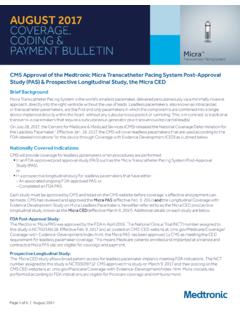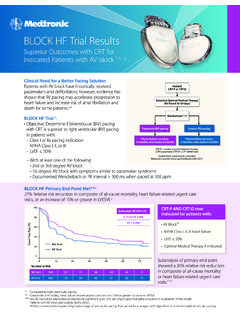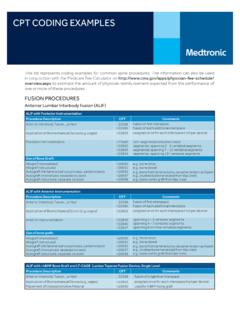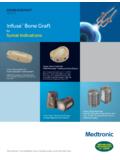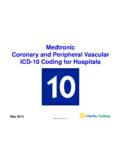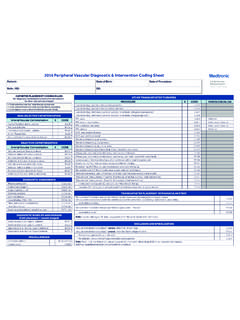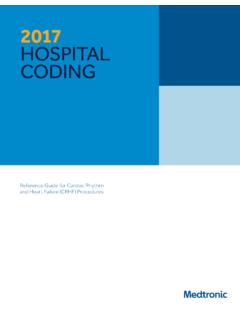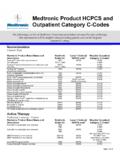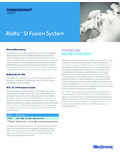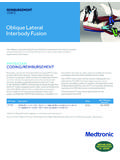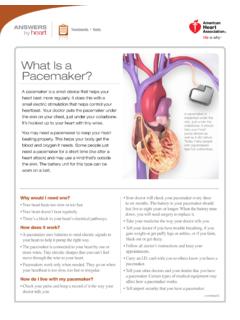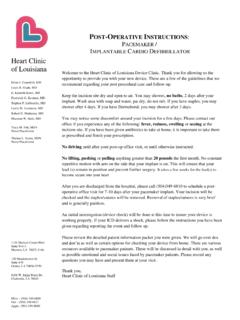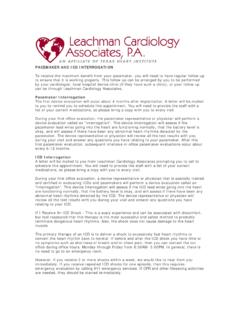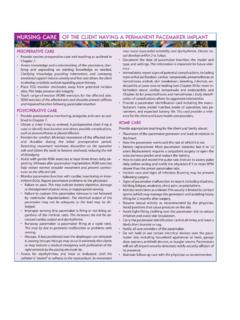Transcription of DUAL CHAMBER TEMPORARY EXTERNAL PACEMAKER
1 The Next Generation TEMPORARY PACEMAKER Enhanced user interface with improved visibility and increased responsiveness Improved low battery indicator Single and dual CHAMBER pacing capabilityDUAL CHAMBER TEMPORARY EXTERNAL PACEMAKERM odel 5392 SpecificationsModesDDD, DOO, DDI, AAI, AOO, VVI, VOOB asic Pacing Rates30 200 ppm Upper Rate80 230 ppmRapid Atrial Pacing Rates80 800 ppmOutput AmplitudeAtrial: 20 mAVentricular: 25 mAPulse WidthAtrial: msVentricular: msSensitivityAtrial: 10 mVVentricular: 20 mVA-V IntervalPaced A-V (PAV): 50 250 Auto20 300 ManualSensed A-V (SAV):50 250 Refractory PeriodAtrial: 150 500 ms (PVA RP)Atrial Refractory after an Atrial event is equal to the AV intervalVentricular: NAVentricular BlankingPace: 200 msSense: 120 cm ( in) cm ( in) cm ( in)Weight680 g (24 ounces)Battery TypeTwo IEC type LR6-sized (AA-sized) V alkaline batteries (Duracell MN1500, Eveready E91 or equivalent)Battery Life9 days typical, 7 days minimumBrief StatementModel 5392 Dual CHAMBER TEMPORARY PacemakerIntended Use.
2 The medtronic Model 5392 dual CHAMBER TEMPORARY PACEMAKER is intended to be used in conjunction with a cardiac pacing lead system for TEMPORARY single or dual CHAMBER pacing in a clinical environment by trained personnel. The TEMPORARY PACEMAKER can be used where short-term demand (synchronous) or asynchronous pacing is indicated for therapeutic, prophylactic, or diagnostic purposes. The TEMPORARY PACEMAKER must be used in an environment where the patient is monitored continuously to ensure that it is operating properly and delivering appropriate therapy to the patient. Contraindications: There are no known contraindications to the use of TEMPORARY pacing as a means to control the heart rate.
3 The patient s age and medical condition, however, may dictate the type of TEMPORARY PACEMAKER and lead system used by the physician. Pacing modes which allow sensing in the atrium to trigger a ventricular response are contraindicated in the presence of rapid atrial arrhythmias such as atrial fibrillation or atrial flutter. Atrial pacing is ineffective in the presence of atrial f ibrillation or f lutter. Single CHAMBER atrial pacing is contraindicated in the presence of AV conduction disorders. Asynchronous pacing is contraindicated in the presence of intrinsic cardiac rhythms. Atrial high-rate burst pacing therapy is intended for use in the atrium only.
4 High-rate burst pacing in the ventricle may result in life-threatening arrhythmias. The TEMPORARY PACEMAKER is MR : Monitor the patient continuously while the TEMPORARY PACEMAKER is in use to ensure it is operating properly and delivering appropriate therapy to the patient. ECG monitoring should be in use and defibrillating equipment should be placed on standby and be kept immediately available during pacing lead insertion, pulse generator connection and adjustment, measurements of stimulation thresholds or sensed potentials, and application of antitachycardia burst therapy. Use of high rates in the atrium may result in accidental conduction to the ventricle.
5 Defibrillation equipment should be kept immediately available during high-rate pacing. Operational failure of the TEMPORARY PACEMAKER can occur as the result of battery depletion, mishandling, or random component failure. Complications related to the use of TEMPORARY EXTERNAL pacemakers such as the Model 5392 include, but are not limited to, asystole following abrupt cessation of pacing, inhibition, and reversion. Potential complications related to the use of pacing lead systems with the Model 5392 include, but are not limited to, myocardial irritability resulting in fibrillation, infarction, pericarditis, rejection, muscle and nerve stimulation, and infection.
6 Complication related to inhibition or reversion of the PACEMAKER in the presence of strong electromagnetic interference. Whenever possible, for the safety of the patient, disconnect the TEMPORARY PACEMAKER from the implanted lead system before defibrillating or cardioverting. Excessive defibrillation energy can damage the TEMPORARY PACEMAKER . This can result in a large current f lowing through the implanted lead system and TEMPORARY PACEMAKER , which could reduce intended def ibrillation energy delivered to the patient or cause myocardial damage. A lead with extension cable constitutes a direct, low-resistance current path to the myocardium.
7 During connection and testing procedures, only battery-powered instrumentation should be used. Extreme caution must be taken to properly ground all line-powered equipment used in the vicinity of the patient. Electrosurgical units can cause tachyarrhythmias by inducing current on the leads. Improper connection, displacement or fracture of leads or cables may result in PACEMAKER system failure. Inspect leads and cables for damage before each use. The pacing lead system may cease to function at any time due to improper connections or lead-related problems such as displacement or fracture. Do not modify the TEMPORARY PACEMAKER .
8 Modif ications could impact the TEMPORARY PACEMAKER effectiveness and adversely affect patient safety. See the device manual for detailed information regarding the procedure, indications, contraindications, warnings, precautions, and potential complications/adverse events. For further information, please call medtronic at 1 (800) 328-2518 and/or consult medtronic s website at : Federal law (USA) restricts this device to sale by or on the order of a EN medtronic 2016. Minneapolis, MN. All Rights Reserved. Printed in USA. 03/2016 Medtronic710 medtronic Parkway Minneapolis, MN 55432-5604 USA Tel: (763) 514-4000 Fax: (763) 514-4879 Toll-free: 1 (800) 328-2518(24-hour technical support for physicians and medical professionals)
